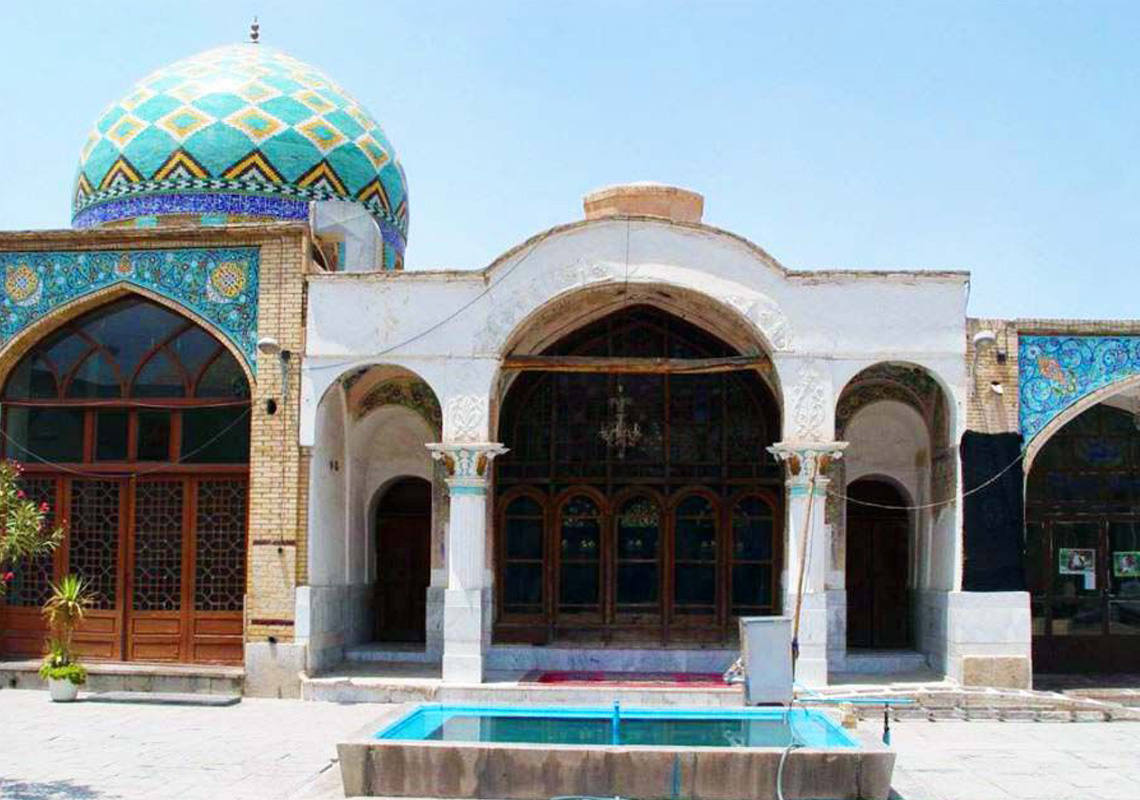Imamzadeh Ahmad is one of the famous shrines in the city of Isfahan located on Imamzadeh Ahmad Alley, Neshat Street. This sacred shrine belongs to Sayyid Jalil al-Qadr Sayyid Ahmad, whose ancestry reaches Imam Baqir. Imamzadeh Ahmad is a square building with a beautiful dome which is tiled.
The dome is adorned with turquoise, white and yellow tiles and it is based on short columns. At the entering of the courtyard of Imamzadeh Ahmad, there are several verandas with beautiful tiles and plaster. It seems that the current building of Imamzadeh Ahmad were built according to the inscription on the main courtyard in 1115 AH and coincides with the rule of King Hussein Safavi. The calligraphy of this beautiful inscription is based on an individual mosaic script by Ali Naqi Emami.
According to an inscription on one of the porches of Imamzadeh Ahmad, the building was built in 1115 AH by an architect named Sharif al-Monjem. The inscription itself is also called a calligraphy by Ahmad Hosseini.
At the door and inside the walls of Imamzadeh Ahmad there are beautifully written lines of holy Quran. A famous artist named Mohammad Ali Naqi Emami made a lot of work on Imamzadeh Ahmad’s walls in 1115 AH. Another inscription on Nastaliq line shows the reconstruction of the building during the time of Fath Ali Shah Qajar.
In one of the porches, the name of Zeleh Sultan is inscribed on a golden inscription with a beautiful Solceline. Solceline is a type of inscripting in Iran.
According to the inscription and the motto of the monument in 1290 AH, it was rebuilt by Zeleh Sultan and a beautiful woodwork adorned with Chinese knot art and inlaid on the tomb.
In some luxury historical houses in Isfahan some of these arts can be seen. For example; kianpour old house in Isfahan which dates back to Qajar era. There are some of these traditional hotels in Iran that have the same art. Kianpour boutique hotel can host you with a vast variety of these arts. In this case you can stay at a luxury house accommodation which is only 3.5 km away from Imamzadeh Ahmad shrine. You can choose to take a walk, rent bikes, call for taxi or use other types of public transportation such as subway etc. in order to get there.
Another valuable inscription of Imamzadeh Ahmad is an inscription on the theme of poems by Mohtasham Kashani, written in 1321 AH. One of the wonders of Imamzadeh Ahmad is the presence of a black stone and, of course, a transparent stone on one of the outer walls, which has 3 meters high and it has the Kufic script of 563 AH.
Some believe that this stone, known as Sumnat, was brought to this sacred place by Sultan Mahmud from India. According to this inscription, it was built on the tomb of ImamZadeh Ahmad before the Safavi era and has been expanded and reconstructed by the Safavi kings.
Other celebrities have also been buried in the Imamzadeh Ahmad area, including the wife and daughter of Amir Kabir, Mullah Homay Shirazi and Mirza Mohammad Nasir. The graves are housed in rooms with beautiful plaster decorations and eye-catching roles. The last inscription dated to 1322 AD shows that a lady by the name of Eftekhar Azam Massoud has borne the cost of rebuilding Imamzadeh Ahmad.
Imamzadeh Ahmad is one of the most famous and blessed monument of Isfahan. Besides architecture and decoration of the monument, private tomb adorned with various types of murals, inscriptions, sculptures and graves with beautiful carvings makes these place unique. Although, as a result of recent repairs, all of the old tombstones of the courtyard of the Imamzadeh Ahmad (except the entrance stone lion) have been removed and damaged, but the architectural and gravestones in the tomb of "Hamdamo-Saltane" have been well preserved over time.
The tombstones of her and some other tombs of Imamzadeh Ahmad, such as the "Khosrokhan Qashqai" tombstone, are among the most exquisite monuments of Isfahan that has most prominent artistic and historical works in terms of motifs, lines and precision.
The gravestones (if they are safe from natural disasters and human destruction) are embedding documents that, in addition to their visual features and aesthetic aspects, provide valuable information from a historical, political, and sociological perspective. Therefore, it is necessary to maintain and study them.







